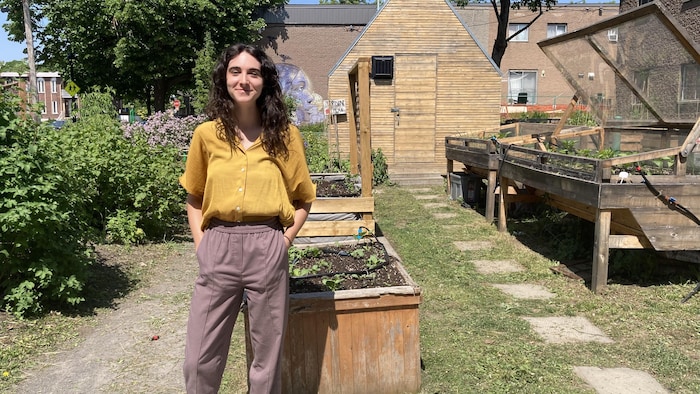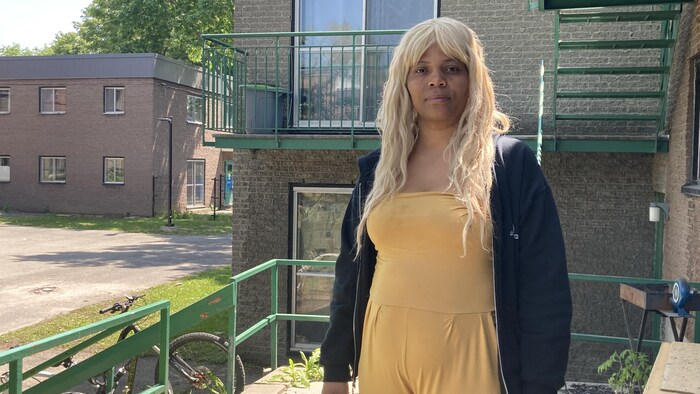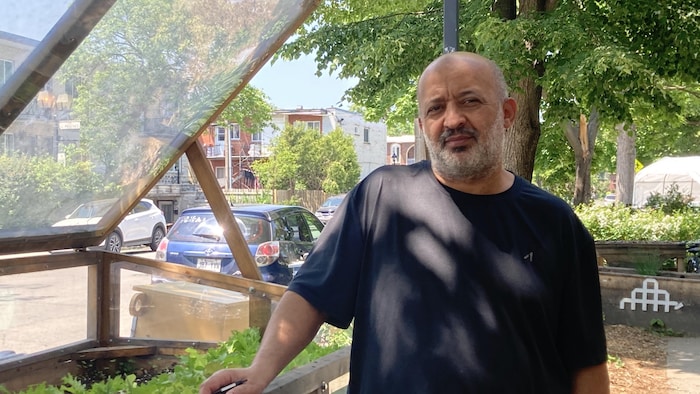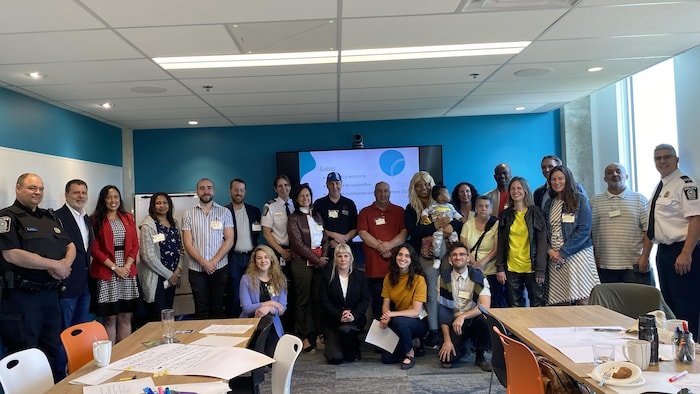Residents of Montreal’s low-cost housing (HLM) La Pépinière are trying their hand at discussing their problems directly with leaders from the health, housing, police, city and community sectors.
Welcome to HLM La Pépinière located in East Montreal. Here, about 300 people, families and bachelors live in 192 residences built in the 1970s.
Part of the dwelling is under renovation, the rest is being maintained normally and some apartments are vacant. At the center of housing is Project Harmony, a community organization that provides services to residents, such as food aid, no-holds-barred day care, a youth center and a community garden.
The courtyard of HLM La Pépinière in Montreal.
Photo: Radio Canada/Karen Mathieu
Security issue
The citizen mobilization worker, Laurie Hito, has been appointed to mobilize and support the tenants so that they can find solutions to the problems that have been identified, such as housing insecurity.
In the blocks downstairs there is a laundry room and storage room where people can put their things. These are free places where groups of young people go to eat, cool off, eat, and drink. The doors of the blocks are often broken, and it is easy to get inside. And when the units are vacant, it’s even worse.

Worker responsible for mobilizing citizens for the Harmony Project, Laurie Hito in front of the community garden at HLM La Pépinière.
Photo: Radio Canada/Karen Mathieu
The tenant, Frantzcesca Cornet, lives at public housing Since her teens and today, she is raising her five children there and expecting a new baby soon.
I’ve lived here since I was 16 years old. I am 43 years old today. I find that young people don’t respect what doesn’t belong to them any less. There is sabotage. My daughter had her bike vandalized. There are also flights
as you say.
There is no room for her to leave the house. No, because it won’t change anything! The problem may be elsewhere
affirm with conviction.

Frantzcesca Cornet is part of a group of tenants who are taking action to make their living environment safer.
Photo: Radio Canada
I understood that problems must be resolved. Don’t run away from them! That’s why I decided to fight!
Just like Francesca, Ahmed Al-Sharifi who lives in public housing La Pépinière, who has been with her family for six years, wants to turn things around. We must participate for the welfare of society
He said.
the public housing Close to Louis-Riel School. Loitering is observed due to this proximity and because the students have no space to congregate and so come to the plane [HLM, NDLR]
Ahmed explains.
He adds, moreover, that housing should be further renovated.

Ahmed Sharifi, a tenant at HLM La Pépinière in Montreal.
Photo: Radio Canada/Karen Mathieu
CEO, chief executive officer and tenants are at the same table
Safety issues are not new, but this time to solve the problem, a new approach has been attempted by a team of researchers led by Professor and holder of the Research Chair in Social Inequalities in Health, Janie Sowell. She wanted to innovate and make a difference.
We realized that tenants face many obstacles to succeed in improving their residential environment. They also live in situations where they have no control, no power, and no significant power to change things
The researcher explains.
We had the idea of getting the tenants together around one table public housingwho have little power over their environment, and people who have more power than themselves, the leaders!
At first, this approach surprised. Local workers told the researcher that they had no direct contact with the leaders. So why do tenants achieve this? But the general directors and CEOs of health, housing, police, cities and society have agreed to take part in the project. They now have two meetings a year on their schedule with the tenants, one of which has already taken place.
Participants in the first meeting between senior managers and tenants at HLM La Pépinière in Montreal.
Photo: Harmony Project
I think encounters with key leaders are empowering, empowering, and telling citizens, ‘We’re still here to help you, and those who are there for you every day will continue to do their work.’
explains Rozier Mitellos, Assistant Public Administration at the Montreal Municipal Housing Office (OMHM), who is one of the co-leaders of this community alliance.
However, he specifies that even leaders have limitations on respect, but that doesn’t mean they can’t do anything.
We have no more leeway, but the theme of our strategic planning is daring to do otherwise. So, with the same financial benchmarks, we’re trying to do things differently.
For example, he says, the schedule or priorities of the maintenance and repair worker doing the cleaning can be reviewed and adapted to the needs of a particular residence. Same for the watchman who provides the evening watch, his schedule can also be adjusted. On the other hand, for additional budgets, theOMHM You should discuss with the Société d’habitation du Québec.
Another note: the office runs approximately 900 public housing Leaders usually have busy schedules. It seems impossible that the leaders could meet all the tenants who live there.
We certainly cannot reproduce it in all of us public housing. Anyway, even if the living environments are similar, the dynamics are different. We can’t think of a solution that we can fully implement public housing. Elsewhere, there are other experiments being done that are working very well
Rouzier Métellus argues. The intention is to inspire!
The courtyard of HLM La Pépinière in Montreal.
Photo: Radio Canada/Karen Mathieu
The importance of communication
Despite the limitations of the various partners, Professor Janie Hall believes that direct contact between senior managers and tenants is essential to understanding each other’s realities.
It enables human encounters that transcend statistics. During the last meeting, the tenants discussed the fact that people broke into vacant units and how that created a sense of insecurity. It was poignant and the emotional charge, we could feel it.
We know that in order to make people change, we must address not only the head, but also the heart.
According to her, the approach also allows tenants to better understand the work of managers and the way decisions are made.
In any case, the tenants are confident and hope to see an improvement in their conditions. I really like that meeting. I felt that they were ready to work with us, that we were one
Francesca Cornet says.
They couldn’t say that it was just a team leader who didn’t assess the situation well! They are leaders, so if they say something, it must be true
Ahmed Al-Sharifi adds.

“Amateur entrepreneur. Professional internet expert. Zombie maven. Incurable pop culture scholar.”


:format(url)/cloudfront-us-east-1.images.arcpublishing.com/lescoopsdelinformation/MJJLV2ZZGRA7NOZ7RPP6N5DJFI.jpg)






More Stories
Mother's Day | For the gourmet mother
The watch of the richest passenger on the Titanic has been sold for a fortune at auction
News from Marc-Andre Collier